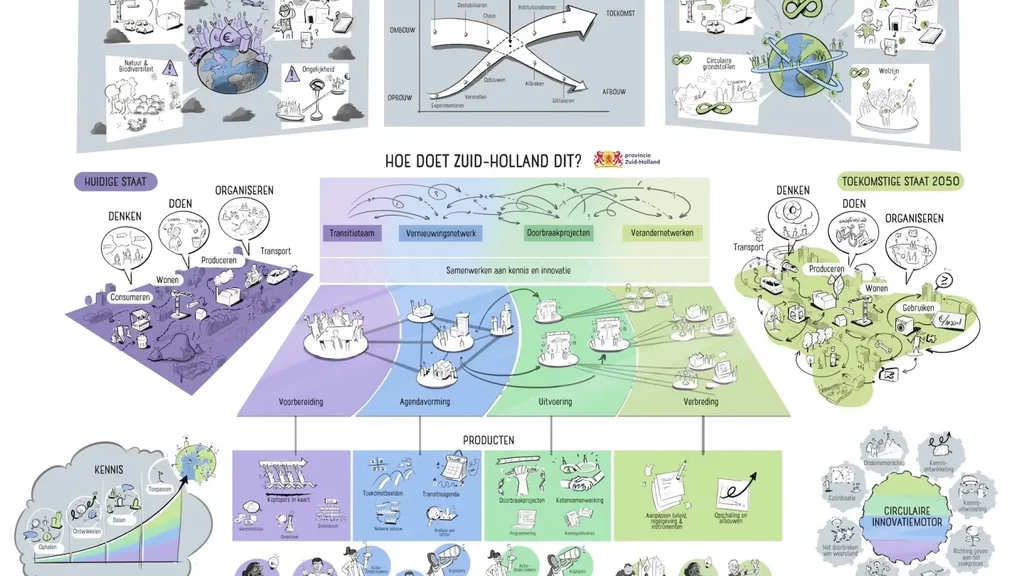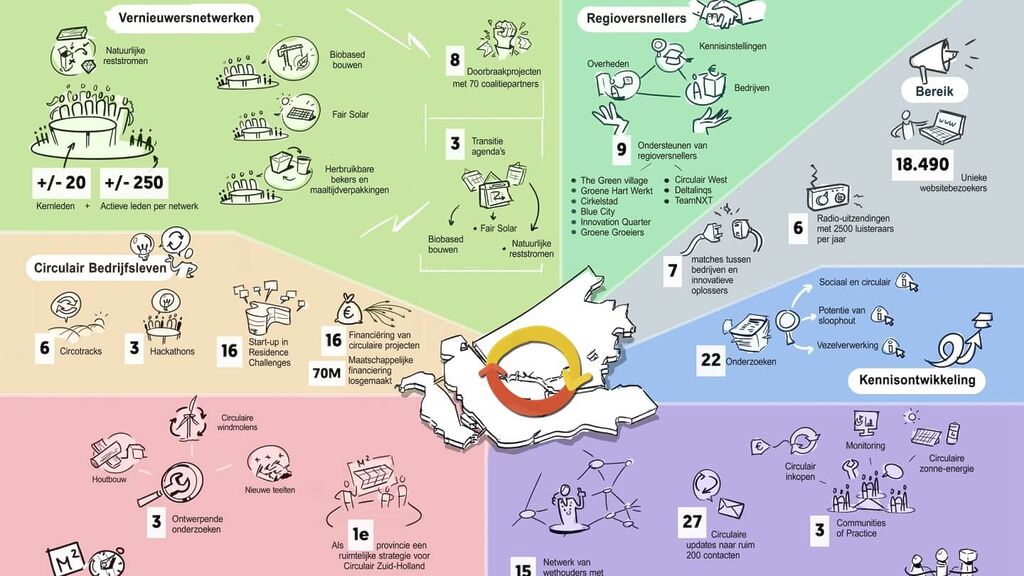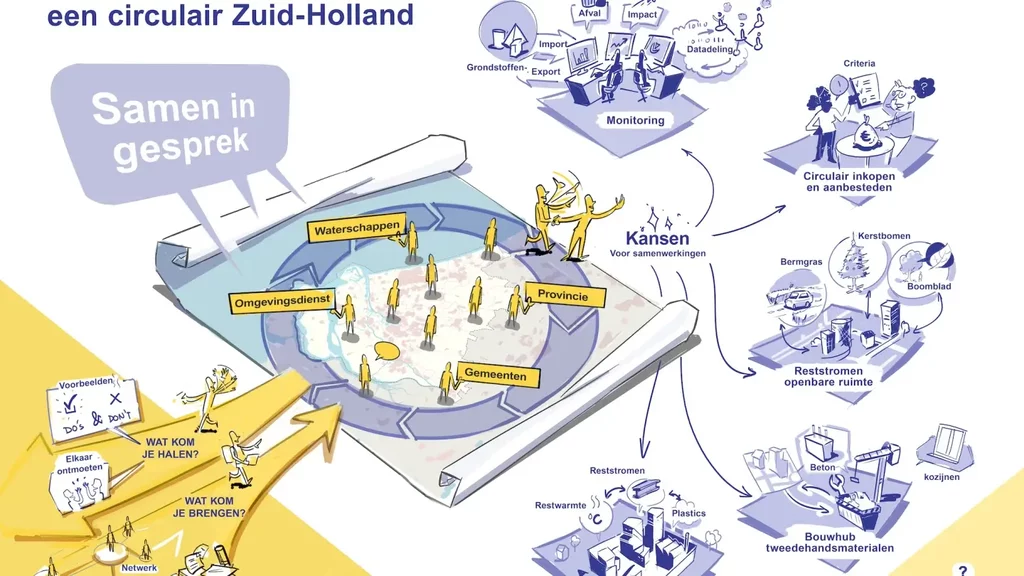Moving together towards a sustainable future
Robert Tekke, director of the Circular South Holland task and employed by the Province of South Holland, likes a challenge. His team builds coalitions and networks to make the transition to a circular society concrete and tangible together with entrepreneurs, civil servants and administrators. How do you actually shape such a transition within a government organisation? Janita talked to Robert about the challenges he faces, switching between the upper and lower stream, and the role visual thinking plays in these complex changes.
Challenges of transition
“I don’t call myself a programme manager,” says Robert Tekke. “An early-stage transition, like circular, is all about energy and movement. A lot is still unclear and you want to start shaping that together. You try to drive the innovation. Sometimes you organise that as a project, sometimes as a process or a programme and even more often as a transition where doing and learning are central. Even if we are not sure if it works, we are going to do it. And then also spend time learning and adapting.”

A diverse team with one story
In Robert’s team, diversity is important. “Each team member is unique, the variation in terms of studies and work experience is great, especially in soft skills. We have people from the business world, who have worked in government for years or have a background in research, education or marketing. Everyone brings their own qualities and background. These differences help us in the transition. That gives different perspectives, even if it can sometimes lead to misunderstanding.”
“That diversity also helps us in working with our partners. But we are not there yet. The circular transition will only succeed if everyone can participate. We are far from that yet. Those different perspectives also fuel the circular story. It’s about economy as well as living and working within the limits of our planet, as well as healthy and social.”
In collaboration with Flatland, Robert has therefore been working on a single shared story.

We are taught not to make mistakes.
According to Pekka Peura, a teacher from Finland, this has to do with the way we have designed our education. You get grades if you don’t make mistakes and vice versa. Pekka’s vision (and that of many other teachers we spoke to) is to make education a safe place to experiment and make mistakes. With a teacher who creates a supportive environment where children reflect on the mistakes they have made. To learn to learn and continue to develop.

Robert explains that circular often focuses on the economic domain, with a lot of attention on classical innovation methodologies. Circular South Holland starts from the idea that it is about a circular society and that it is a real transition. It is about a fundamentally different way of thinking, acting and organising that goes beyond economics.
We look at the dynamics in society, where is the energy in people and networks? At what is often still invisible. To explain who we are and what we do, our team regularly uses ‘talking pictures’. These make it easier to tell how we are working on the transition, both inside and outside. Over time, we have developed a lot of additional plates. Like a picture of our ecosystem, or the infographic showing what impact we have made with circular South Holland.”
Early in a transition, it’s about people, energy, leadership and guts. Not knowing and accepting that. That is our starting point. We built our story on that.
Upstream and downstream
Change starts under the surface, at what we call ‘the undercurrent’. This includes things that are usually not made explicit, not expressed directly such as beliefs, drives, feelings. They are invisible, but palpable and of great influence. In transitions, this often involves uncertainty and discomfort but also differences in sense of urgency. Today’s interests are often clear, but those of the future are uncertain. Making that negotiable is important. By really listening, being curious. The upstream is much more visible and includes hard aspects such as goals, strategy and procedures.
Robert continues: “I do like issues where a lot is unfinished and where interests come together that don’t seem to fit immediately or are unclear. Such a transition process requires conscious switching between the upper and lower stream. Sometimes
the question is: ‘What does this mean for you? What do you need to participate despite all the uncertainties?’ Other times, ‘What products are we going to make?’ Or ‘How do we organise it?’ My role varies. Sometimes I make it sharp, ask uncomfortable questions, sometimes my role is to think along or to connect people. And with circular there is often no blueprint, then it’s about creating something new together.

The chain in focus
When working with networks, Robert and his team always start with an analysis of the issue. But even more important is what is really happening in those networks around a particular theme and issue. “We look for the people with whom there is energy, who are motivated and want to get started. But we will also listen to those who may want to, but are not sure how. Who are still in doubt. What do they need? If we think that together these people can and want to make a difference, we bring them together to discuss and visualise their ambitions and wishes. Here, we often use visualisations. This can release a lot of energy. Especially when entrepreneurs feel that something will become a (social) problem in the future, but they cannot solve it themselves.”
Policymakers often ask us from which theory we work. We use the principles of transition theory and have made our own translation on that. And that, in turn, is visualised. These visualisations help us and provide guidance when things become complex for ourselves, but also precisely to share and discuss with the partners we work with.
Take, for example, the use of reusable cups and meal packaging. Besides behaviour, this is a real logistical and economic issue. “This inconvenience is felt, but it cannot be solved by one organisation alone. The whole chain is needed.” By drawing out that chain and the forces at play, people can see their role in the whole. This also creates a common goal, which contributes to intrinsic motivation.

As Flatland, we help Robert and his team make sense of those different perspectives and map where the energy is, both in the upper and lower streams. Visualisations help give a complete picture, uncover the layering and serve as a recognisable record. “Drawing structures complexity during conversations and provides guidance and overview. Moreover, it looks attractive. That draws people in!” says Robert.